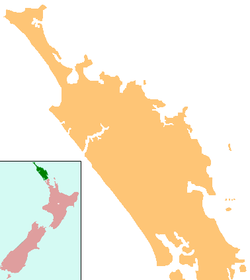Te Hāpua
Te Hāpua | |
|---|---|
 Te Hapua Wharf | |
 Te Hāpua | |
| Coordinates: 34°31′2″S 172°54′45″E / 34.51722°S 172.91250°E | |
| Country | New Zealand |
| Region | Northland Region |
| District | Far North District |
Te Hāpua is a community on the shores of the Parengarenga Harbour in Northland, New Zealand. The road to Te Hāpua leaves State Highway 1 at Waitiki Landing.[1]
Te Hāpua is the most northerly settlement in the North Island of New Zealand. The 2013 Census recorded 84 people in the Te Hapua region.[2]
The New Zealand Ministry for Culture and Heritage gives a translation of "the lagoon" for Te Hāpua.[3]
Matiu Rata, Cabinet Minister in the Third Labour Government in the 1970s and founder of the Mana Motuhake party, was born in Te Hāpua in 1934.[4]
The 1975 Māori land march left Te Hāpua for Wellington on 14 September 1975 (Maori Language Day).[5]
Te Hāpua's Te Reo Mihi Marae is a traditional meeting ground for Ngāti Kurī,[6] and includes Te Reo Mihi meeting house.[7]
Demographics[]
| Year | Pop. | ±% p.a. |
|---|---|---|
| 2006 | 165 | — |
| 2013 | 144 | −1.93% |
| 2018 | 141 | −0.42% |
| Source: [8] | ||
Statistical area 7000000 covers 285.49 km2 (110.23 sq mi)[9] including Te Hāpua and the area north of Waitiki Landing. It had a population of 141 at the 2018 New Zealand census, a decrease of 3 people (-2.1%) since the 2013 census, and a decrease of 24 people (-14.5%) since the 2006 census. There were 60 households. There were 75 males and 66 females, giving a sex ratio of 1.14 males per female. The median age was 48.1 years (compared with 37.4 years nationally), with 24 people (17.0%) aged under 15 years, 30 (21.3%) aged 15 to 29, 69 (48.9%) aged 30 to 64, and 21 (14.9%) aged 65 or older.
Ethnicities were 14.9% European/Pākehā, 89.4% Māori, 6.4% Pacific peoples, 2.1% Asian, and 0.0% other ethnicities (totals add to more than 100% since people could identify with multiple ethnicities).
Although some people objected to giving their religion, 12.8% had no religion, 14.9% were Christian and 63.8% had Māori religious beliefs.
Of those at least 15 years old, 3 (2.6%) people had a bachelor or higher degree, and 54 (46.2%) people had no formal qualifications. The median income was $16,200, compared with $31,800 nationally. The employment status of those at least 15 was that 36 (30.8%) people were employed full-time, 21 (17.9%) were part-time, and 12 (10.3%) were unemployed.[8]
Education[]
Te Hāpua School is a coeducational full primary (years 1–8) school with a decile rating of 1 and a roll of 31.[10] It is New Zealand's northernmost school.
Climate[]
| Climate data for Te Hāpua, Northland, 4 m | |||||||||||||
|---|---|---|---|---|---|---|---|---|---|---|---|---|---|
| Month | Jan | Feb | Mar | Apr | May | Jun | Jul | Aug | Sep | Oct | Nov | Dec | Year |
| Average high °C (°F) | 24.4 (75.9) |
24.9 (76.8) |
23.4 (74.1) |
21.4 (70.5) |
19.1 (66.4) |
17.1 (62.8) |
16.4 (61.5) |
16.5 (61.7) |
17.5 (63.5) |
18.7 (65.7) |
20.3 (68.5) |
22.5 (72.5) |
20.2 (68.4) |
| Daily mean °C (°F) | 20.3 (68.5) |
20.7 (69.3) |
19.4 (66.9) |
17.6 (63.7) |
15.4 (59.7) |
13.6 (56.5) |
12.9 (55.2) |
12.9 (55.2) |
13.9 (57.0) |
15.1 (59.2) |
16.7 (62.1) |
18.5 (65.3) |
16.4 (61.5) |
| Average low °C (°F) | 16.2 (61.2) |
16.5 (61.7) |
15.4 (59.7) |
13.9 (57.0) |
11.8 (53.2) |
10.1 (50.2) |
9.4 (48.9) |
9.3 (48.7) |
10.3 (50.5) |
11.6 (52.9) |
13.1 (55.6) |
14.6 (58.3) |
12.7 (54.9) |
| Average precipitation mm (inches) | 61.0 (2.40) |
65.0 (2.56) |
75.0 (2.95) |
95.0 (3.74) |
85.0 (3.35) |
115.0 (4.53) |
116.0 (4.57) |
107.0 (4.21) |
88.0 (3.46) |
66.0 (2.60) |
63.0 (2.48) |
62.0 (2.44) |
998.0 (39.29) |
| Source: Climate-data.org[11] | |||||||||||||

Notes[]
- ^ Peter Dowling, ed. (2004). Reed New Zealand Atlas. Reed Books. pp. map 2. ISBN 0-7900-0952-8.
- ^ Harris, Sarah (14 May 2015). "Living in Te Hapua". Stuff. Retrieved 23 May 2021.
- ^ "1000 Māori place names". New Zealand Ministry for Culture and Heritage. 6 August 2019.
- ^ David Barber (28 July 1997). "Obituary: Matiu Rata". The Independent.
- ^ Metge, Joan (2004). Rautahi: The Maoris of New Zealand. p. 112. ISBN 0415330572.
- ^ "Te Kāhui Māngai directory". tkm.govt.nz. Te Puni Kōkiri.
- ^ "Māori Maps". maorimaps.com. Te Potiki National Trust.
- ^ a b "Statistical area 1 dataset for 2018 Census". Statistics New Zealand. March 2020. 7000000 (7000000).
- ^ "ArcGIS Web Application". statsnz.maps.arcgis.com. Retrieved 23 May 2021.
- ^ Education Counts: Te Hapua School
- ^ "Climate Data for Cities Worldwide". openstreetmap.org. Retrieved 19 December 2019.
{{cite web}}: CS1 maint: url-status (link)
External links[]
| Wikimedia Commons has media related to Te Hapua. |
- Far North District
- Populated places in the Northland Region
